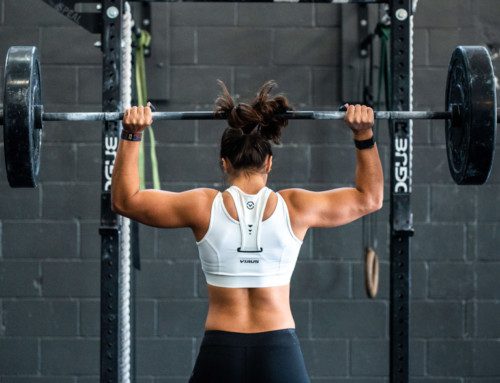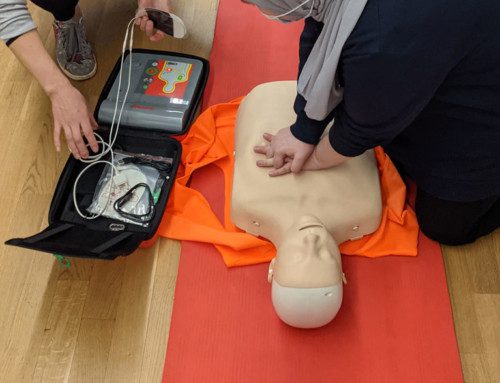Do you ever wonder what the best golfer stretches are? Players who have sustained injuries or have specific limitations may find certain movements more helpful, but we believe the following stretches are essential for the game of your average golfer:
Trunk Rotations
As a critical element to your swing and often an area of tightness, trunk rotation is an important stretch for golfers to perform. The goal is to feel a stretch in your mid-back, helping to elongate the trunk musculature. This stretch helps golfers by allowing them to increase their range to assist with their swing as well as prevent injuries from tight muscles if they tend to force the rotation. Here are two variations of trunk rotations for golfers to try:
In Standing
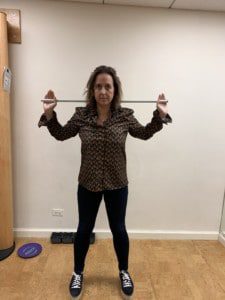

Place a golf club behind your neck or in front of crossed arms. Keeping your hips facing forward, rotate to the left and hold for 20 seconds, then switch to the right and hold the position for another 20 seconds. This stretch can be felt on either side of your back.
Lying Down
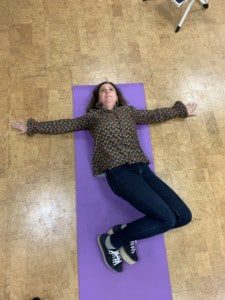

Lie flat on your back, placing your arm out to your side in a ‘T’ position. Bend both your knees and allow them to fall to one side of your body, keeping the opposite shoulder on the floor. Hold this position for 20 seconds on each side and repeat three times. For a deeper stretch, place your arms straight in the air and allow them to fall in the opposite direction of your knees, creating a higher torsion (twist). Make sure to breathe and not to force the rotation, instead aiming to feel a comfortable pull.
Wrist Stretches
As many golfers know, golfer’s elbow or tennis elbow are common injuries in golf. The mechanism is often from gripping the club too tightly or cocking your wrist in the backswing or follow-through. Stretching out the forearm with wrist stretches can help prevent overuse as well as tightness from gripping. We suggest stretching both sides of the forearm on both arms because of the dynamics of the swing.
Wrist Extensors

Place your arm straight and point your finger to the floor, causing your wrist to go to 90 degrees. You should begin to feel the stretch on the top of your forearm. From there, you can place the other hand on top of your fingers, adding more pressure while rotating the fingers in and out to change the placement of the stretch on the forearm for a deeper stretch.
Wrist Flexors

This is the opposite motion as a wrist extensor, used to help stretch your palm and the inside of your arm. For wrist flexors, rotate your arm so that your palm is up and with your other hand, bring your fingers back to 90 degrees. This brings a stretch through the palm into the wrist. Just as with wrist extensors, you can rotate your fingers in and out for added depth in the stretch.
Hamstring Stretch
Hamstring muscles are the large muscles on the posterior aspect of our thighs. Because we spend a large portion of our days sitting, they are often short and tight, which is not ideal for golfers. Tight hamstrings can limit golfers’ ability to bend forward when setting up for a swing, causing more of the movement to come from their backs. Another possible injury point for this muscle is during the golf swing when weight transfers from one leg to the other during follow-through. By warming up and stretching the hamstrings regularly, much of this shortening can be prevented.
Standing Hamstring Stretch

Place one leg on a bench or golf cart with the knee straight. Hinge forward from the hip, making sure to keep the back straight until you start to feel a gentle pull in the hamstring. The key to implementing this stretch is making sure you do not round your back. Ideally, the pull should be in the middle of the muscle and not behind the knee or in the buttocks. Hold this pose for 20-30 seconds on each side, doing so three times.
Hip Flexors
Most golfers understand that they need to rotate their hips on the follow-through to face the fairway after hitting the ball. Limitations in your hips can also affect your trunk rotation. The golf swing position shortens the hip flexors, as does sitting. Lengthening these muscles can make a large impact on your golf swing and also improve hip health.
In Half Kneel
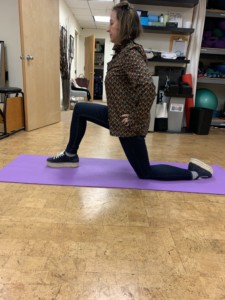
Place one knee on the ground and the other knee at a 90-degree angle so that the foot is on the ground and the knee is bent. Then lean forward, allowing the leg with the knee on the ground to feel the stretch in the front of the thigh and even up into the stomach. This stretches the rectus femoris muscle, which is a hip flexor muscle that crosses both the knee and hip joint. Hold for 20 seconds and do the exercise three times on each side.
Shoulder Stretch
Most golfers assume that you should be stretching your rotator cuff or your scapular by bringing your arm across your body. However, one of the most effective stretches is actually for the inferior capsule of your shoulder. By helping to make sure that the capsule has its full range, you’ll address more than one motion of the shoulder.
Sleeper Stretch

Lie on your side so that your body is perpendicular to the floor, placing your arm straight at a 90-degree angle and then bending your elbow to 90 degrees, as well. Then, place your other hand on top of your arm to be stretched and add pressure to get your hand to the floor. Hold the pose for 30 seconds, following these steps three times.
These stretches are sure to benefit any golfer, regardless of their fitness level. Are you looking for more golf-friendly exercises? Set up an appointment with SetPT today!




